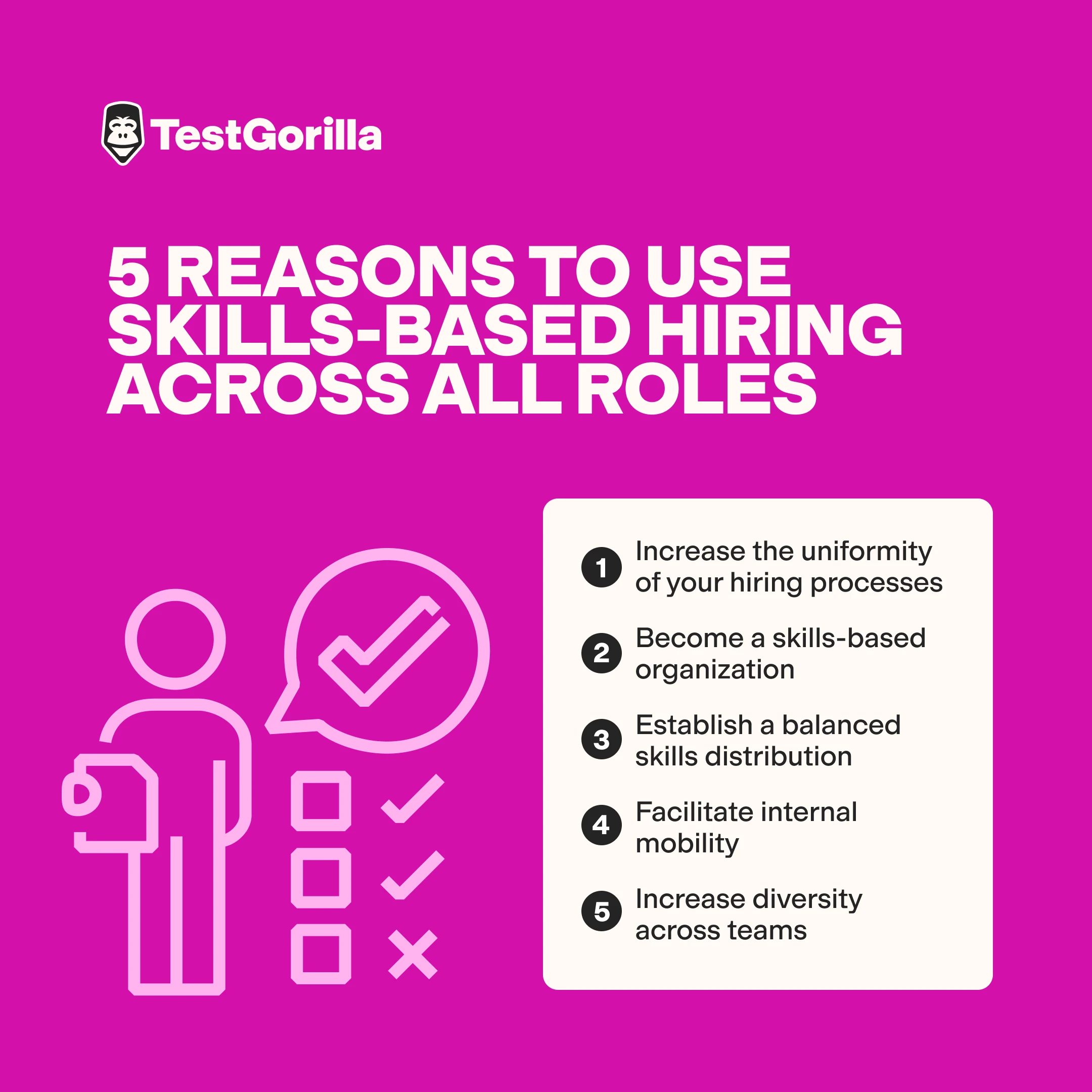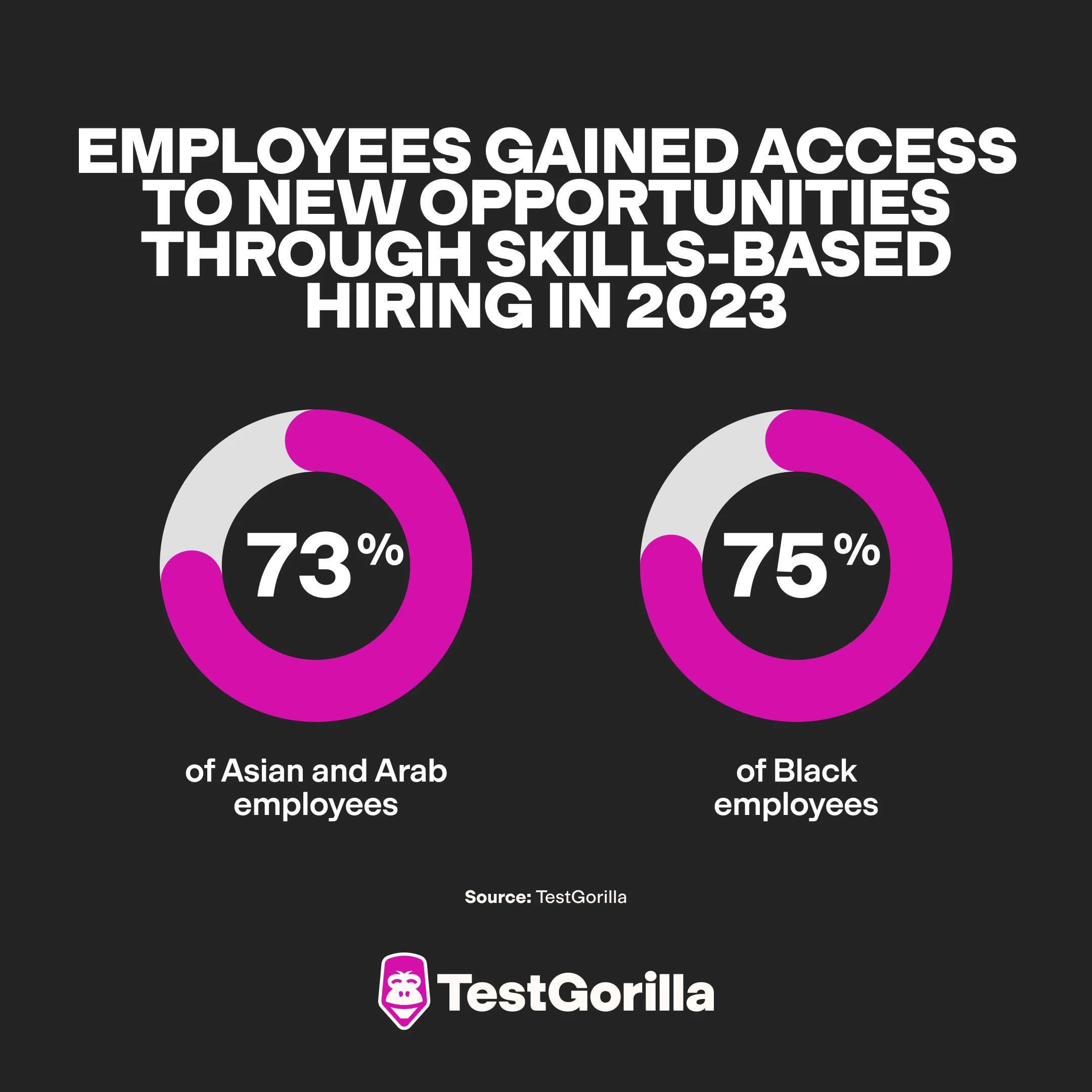Does skills-based hiring scale? Your guide to using it as an org-wide recruitment strategy
With 73% of employers using skills-based hiring in 2023, the way we hire is truly evolving towards practices that focus on skills. Technology is also evolving to facilitate this shift. There’s a real need for employers to be able to reliably measure and quantify the skills that their applicants have, and software companies that specialize in building science-backed skills-based hiring solutions are there to meet that need. As a result, skills-based hiring solutions are more accessible than ever.
TestGorilla is one of those companies, and, as part of the IP development team here, I’m involved in the creation and development of the tests in our test library. With 400 tests and counting, our library is designed to offer employers an organization-wide skills-based hiring solution – i.e. with TestGorilla, you can use skills-based hiring across roles, management levels, and departments, rather than just for one role, or a handful.
In this blog, I’ll walk you through 5 reasons why you should take an org-wide approach to skills-based hiring. Let’s dive in!
Table of contents
Do companies use skills-based hiring at scale?
In my experience, employers that use skills-based hiring in their recruitment process will often just use it for one role or department. This is usually for one of two reasons:
Hiring managers feel assessments would add unnecessary friction to the hiring process – i.e., they're looking to hire for roles where the supply is super tight and people have a lot of options, and they just want to get people in the door as fast as possible. Adding talent assessment to the skills-based hiring process feels counter-productive to them – why add an extra step for these roles and slow things down even more?
A lack of understanding and/or approval of skills-based hiring amongst the wider leadership team. Based on interactions with our own customers, in cases like these the hiring manager who advocates for skills-based hiring usually has previous experience with pre-employment testing tools. They use that experience to push adoption for their own team – but the same awareness doesn't exist elsewhere, and so skills-based hiring is not used beyond that team.
These concerns are valid and to be expected considering skills-based hiring represents a big change from traditional hiring practices. But skills-based hiring does scale, and there are also plenty of examples of companies that use it across roles and departments. Here are some examples.
3 examples of companies using skills-based hiring at scale
1. IBM
Global tech giant IBM is committed to skills-based hiring, and as of 2022 the company has taken a skills-based approach to over 50% of its job openings. People leader Obed Louissant has discussed how the shift began in IBM’s cybersecurity team before spreading throughout the organization:
It's important to talk about techniques – how do you actually get from point A to point B?… the change management is huge. [One way] in which you could run the change is identifying a small cohort of individuals who you can get as champions [for skills-based hiring] in the corporation. So we had a couple of individuals who raised their hand… starting with Cybersecurity we proved that it was working and then we showcased the talent, and that got the flywheel going. – Obed Louissant, Senior VP of Culture & Transformation at IBM
This demonstrates the importance of having skills-based hiring advocates at your organization. These are the people who will champion change and help overcome objections like the ones I highlighted above.
2. Steelcase
A few years ago, office furniture company Steelcase redesigned its talent acquisition process to enable standardized, data-backed, bias-free recruitment. They did this for two reasons: to improve DE&I, and to hire the best talent. Before the changes, their hiring process was inconsistent, with different tools and criteria being used to hire candidates across the organization.
“The whole idea is that we are looking in more places; we are tapping into talent pools we have not connected into before, and we are doing our best to eliminate barriers in the selection process” – Isabel Medellin, Global Director of DEI & Talent Acquisition at Steelcase
To scale their inclusive recruitment processes across the organization, Steeelcase developed a playbook (that was then used to train all recruiters), revamped their job descriptions (to focus on competencies over qualifications), and implemented cognitive ability assessments.
3. TestGorilla
At TestGorilla, we practice what we preach. This means that the application process for every role we hire for includes a skills-based assessment.
We’ve been doing skills-based hiring from the beginning, hiring our own people with our own tests. We truly practice what we preach. TestGorilla the company is a case study for TestGorilla the product; we have a rich and constant feedback loop, and it informs a lot of the improvements we make. What’s more, for proof of the power of skills-based hiring, we don’t need to look any further than the people around us. – Wouter Durville, founder and CEO at TestGorilla
We’ve found that, when you adopt skills-based hiring across roles and departments, 3 things happen: You hire better talent, you make diversity possible, and you have more fun. You can read more about our success with skills-based hiring here. We wouldn’t be the team we are if we weren’t using skills-based hiring across our organization.
Tips for getting buy-in for skills-based hiring
Getting buy-in is crucial for organizations expanding skills-based hiring usage across organizational functions. Here are some tips:
Share skills-based hiring success stories from your team or department. This is a great way to get executive buy-in and spread the word about skills-based hiring.
Share success stories from other organizations. Use the examples above or check out our case studies for plenty of examples of companies that have adopted skills-based hiring and seen outstanding benefits.
Track your data. Take an overview of your hiring process before and after using skills-based hiring. This way, you can demonstrate its impact and show stakeholders how you’ve reduced cost-to-hire, time-to-hire, or mis-hires. The data could help you build a business case internally for using skills-based hiring or-wide.
Ask for help. If you’re using a third-party pre-employment assessment tool like TestGorilla to do skills-based hiring, reach out to them for help and suggestions. If you’re a customer of ours, TestGorilla’s Customer Support teams are more than happy to share resources to help you successfully scale skills-based hiring.
Give them good reasons to scale! I’m about to help you with this one. Read on for 5 reasons why you should use skills-based hiring as an org-wide hiring strategy.
5 reasons to use skills-based hiring across all roles
Here are five reasons to use a skills-based approach across job roles and departments in your organization.
1. Increase the uniformity of your hiring processes
Like the steelcase example demonstrates, having an inconsistent hiring process across your organization can be troublesome for DE&I. If you’re using different tools and criteria across roles and departments, then fairness will vary, and your hiring managers aren’t learning together.
When companies use skills-based hiring approaches for some job roles and not others, it can lead to unfairness in hiring decisions. For example, hiring with traditional methods for STEM jobs but applying a skills-based hiring approach to select customer service representatives can lead to perceptions of unfairness in the recruitment processes.
Research in industrial and organizational psychology suggests that candidates and employees are understandably sensitive to disparities in employee selection processes and that companies should aim to upload procedural justice.
By adopting a skills-first hiring approach across job roles, companies can demonstrate consistency and fairness in their talent acquisition approaches. This uniformity not only streamlines hiring but also enhances the company's reputation as an equitable employer.
2. Become a skills-based organization
Ever heard of a skills-based workforce? How about a skills-based organization?A recent study by Deloitte showed that there is a rising trend of companies adopting organization-wide, skills-based approaches that organize workforces based on skills, rather than jobs. They dub these skills-based organizations.
Instead of turning everyone into the same kind of contributor through standardizing them in jobs, skills-based organizations let people’s uniqueness as humans shine through, with work tailored to their strengths. – Deloitte
While the number of companies adopting the approach is relatively small, those that do are seeing competitive advantages. Skills-based organizations see more inclusive climates, higher employee retention rates, and significantly higher ‘selection hit’ rates when making selection decisions.
When hiring is based on skills, it cultivates a work environment where employees are valued for their abilities and encouraged to develop new competencies. This focus on skill development can lead to higher levels of employee engagement, motivation, and satisfaction. But a true skills-based work culture is only possible if all your hiring efforts are skills-based.
3. Establish a balanced skills distribution
Skills-based hiring is usually put into practice using skills-based assessments, or talent assessments. Alongside being a fair and objective way to hire, skills-based assessments allow you to take stock of the valuable capabilities you have in your company, across job roles. Essentially, you have data that shows you which skills you have, and where. These insights are invaluable for strategic planning, ensuring a well-rounded skill portfolio across the organization. As the Society for Human Resource Management suggests, skills that are in demand also shift over time, particularly in technological industries, and having a good idea of the baseline skills in your talent pool can facilitate next phase hiring, talent training and development initiatives, and succession planning.
4. Facilitate internal mobility
Skills-based hiring data can facilitate internal mobility when companies need to restructure or staff new teams. When companies maintain skills assessment data, they can leverage it to make informed decisions about where to place talented employees within the company in response to changes.
Internal mobility opportunities are critical to retaining skilled employees. Skills-based hiring approaches facilitate internal mobility, allowing companies to retain talent who may otherwise seek otheremployment opportunities when they lack internal career opportunities.
5. Increase diversity across teams
Opportunity@Work and Accenture estimate that there are 71 million people with employable skills who developed their skills outside of formal education and credentialing routes. By focusing on skills, rather than credentials and resumes, companies can tap into talent that would otherwise be hidden behind paper walls.
Our State of Skills-Based Hiring report found that 73% of Asian and Arab employees and 75% of Black employees gained access to new opportunities through skills-based hiring in 2023.
Skills-based hiring reduces unconscious biases in the recruitment process that impact candidates who do make it past initial paper barriers. Left unaddressed, these biases lead to errors in selection decisions, increasing mis-rates, and enabling discriminatory hiring practices.
Applying skills-based hiring across job roles can reduce unconscious bias in hiring decisions across your organization, rather than just for one position or department. companies can make more effective hiring decisions and increase diversity within the company. This is a crucial advantage, since companies need high-performing and diverse workforces more than ever.
3 tips for scaling skills-based hiring
1. Start small
The journey to scaling skills-based hiring will look different in every organization, but the key to success is to build an effective process, and foster confidence in that process, before you revamp everything. Start small – like IBM did by starting with skills-based hiring in their cybersecurity team – track your results, learn, educate, foster buy-in then scale. Rome wasn’t built in a day!
2. Create a playbook
Something that worked for Steelcase was creating a playbook for new and improved hiring processes, and using this to train hiring managers and recruiters across the company. A hiring playbook that covers why and how you’ll prioritize hiring for skills for all roles will increase buy-in and help your people hire with confidence.
3. Choose your champions
Every revolution needs its champions. To scale skills-based hiring processed org-wide, leverage and platform champions for skills-based hiring at your company. These might be the hiring managers who are already using skills-based processes for their teams or departments, HR people (like IBM’s Obed Louissant) responsible for change and transformation, or simply team members who are passionate about shaking up the way you hire.
Implement an org-wide skills-based hiring process with TestGorilla
Embracing skills-based hiring is not just a trend; it’s a strategic move, and companies who use it at scale are future-proofing their workforces. It’s an approach that not only optimizes the recruitment process but also aligns talent acquisition with the broader business objectives, fostering a more skilled, diverse, and agile workforce.
If you’re new to skills-based hiring and want to start, book a free consultation with TestGorilla or sign up for a free plan to get hands-on and try out our skills tests. See below for more recommended reading about skills-based hiring:
Related posts
Hire the best candidates with TestGorilla
Create pre-employment assessments in minutes to screen candidates, save time, and hire the best talent.
Latest posts
The best advice in pre-employment testing, in your inbox.
No spam. Unsubscribe at any time.

Hire the best. No bias. No stress.
Our screening tests identify the best candidates and make your hiring decisions faster, easier, and bias-free.
Free resources
This checklist covers key features you should look for when choosing a skills testing platform
This resource will help you develop an onboarding checklist for new hires.
How to assess your candidates' attention to detail.
Learn how to get human resources certified through HRCI or SHRM.
Learn how you can improve the level of talent at your company.
Learn how CapitalT reduced hiring bias with online skills assessments.
Learn how to make the resume process more efficient and more effective.
Improve your hiring strategy with these 7 critical recruitment metrics.
Learn how Sukhi decreased time spent reviewing resumes by 83%!
Hire more efficiently with these hacks that 99% of recruiters aren't using.
Make a business case for diversity and inclusion initiatives with this data.



















